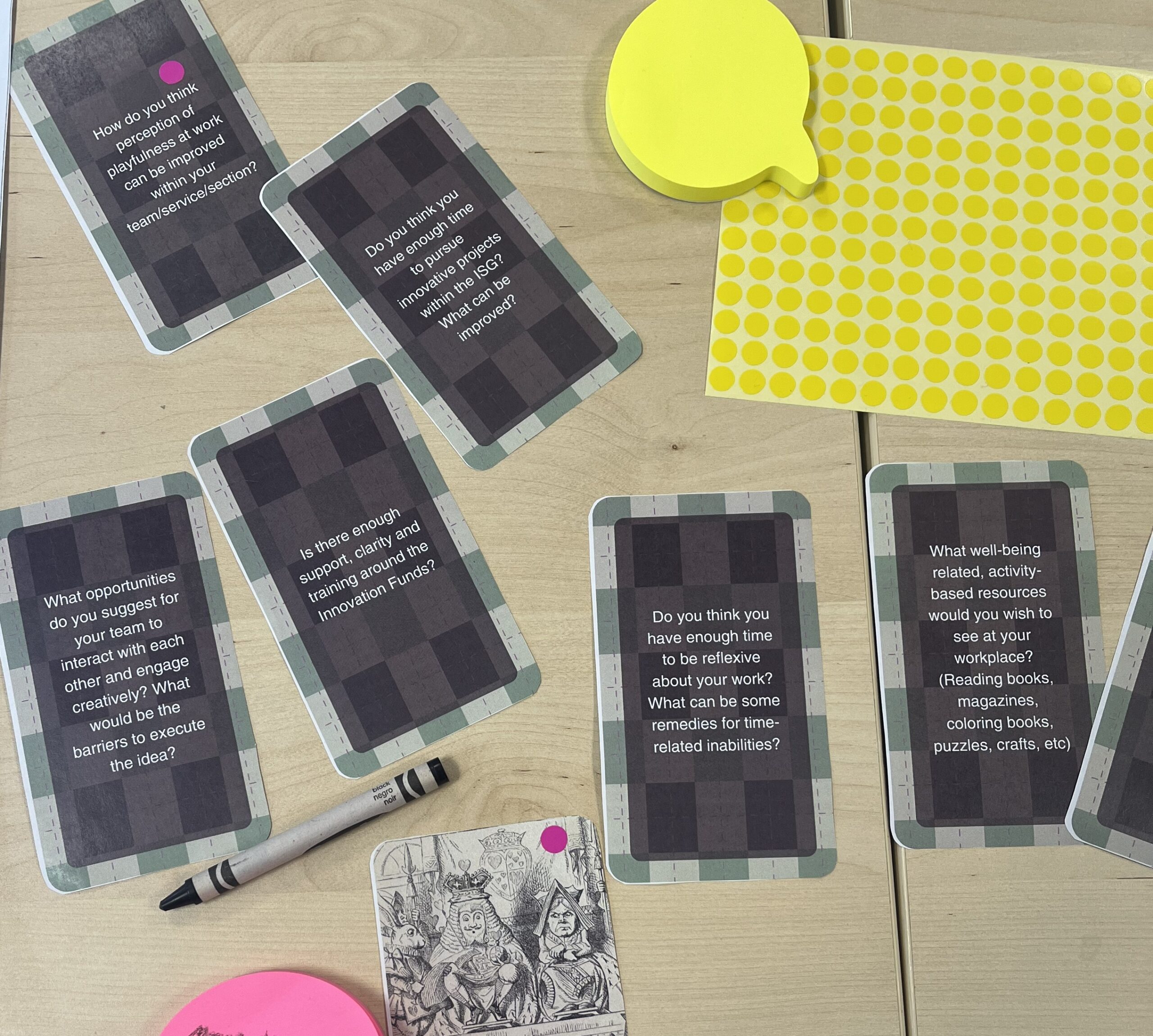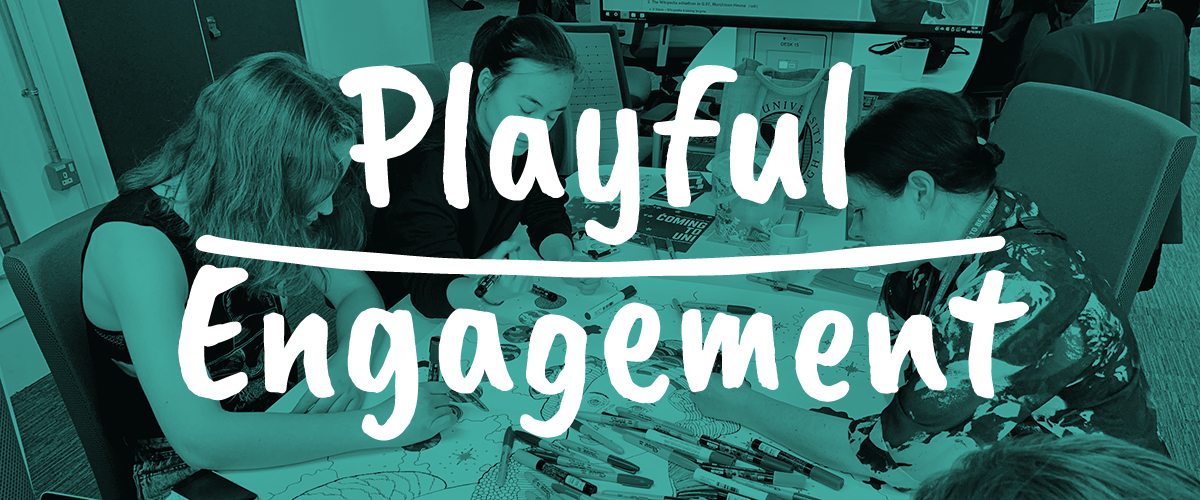Analysis and Future Strategies

Playful Engagement at work refers to the attitude and behaviours of employees that involve approaching tasks, interactions, and challenges with a sense of enjoyment, creativity, and innovation. It involves injecting elements of fun, humour, and spontaneity into the work environment while still maintaining focus and productivity. At ISG this can encompass the ways we approach innovation, creativity, workplace environment, workplace interactions, team building, community building, skill development, outreach, communication, work life balance, achievement and celebration.
Using data gathered from the research, survey, and focus groups, we identified that while there is interest in the concept of playful engagement, there are significant barriers to its implementation across ISG, primarily due to a lack of understanding, practical challenges, and individual differences.Fostering a more playful work environment will need the provision of clear definitions, practical examples, and consideration of the diverse preferences of team members.
There were multiple barriers identified to playful engagement in the workplace, ranging from workload and time constraints to cultural perceptions and organisational policies. These barriers collectively create an environment where playful engagement is difficult to implement effectively. Opportunities identified that playful engagement has the potential to enhance team building and resilience but achieving this requires clear communication, appropriate resources, and an understanding of individual and team dynamics. Future efforts would benefit from a focus on educating team members about the concept and providing tangible examples and strategies for implementation.
Themes Identified
Understanding and Awareness of Playful Engagement
Lack of Clarity: Many team members expressed confusion or unfamiliarity with the concept of playful engagement. Terms such as “frivolous” were used, indicating a need for clearer definitions and examples.
Example: “I had never heard about playful engagement prior to this survey, and am not at all clear how UoE’s infrastructure supports playfulness in the workplace.”
Varied Interpretations: There were different interpretations of what playful engagement means, ranging from incorporating fun activities into work to fostering an innovative and creative work environment.
Example: “The word ‘playful’ doesn’t really engage with our team, whereas ‘innovation’, ‘creativity’ and ‘fun’ seem more relevant.”
Perceived Benefits and Challenges
Benefits: When understood, playful engagement was seen as beneficial for team-building and resilience, particularly during challenging times.
Example: “Playful engagement has lots of benefits from team-building to supporting resilience during more challenging times.”
Implementation barriers: Several barriers to implementing playful engagement were identified, including workload, staffing levels, and physical work environment constraints.
Implementation and Practicality
Practicality: The practical aspects of implementing playful engagement were frequently mentioned, with team members unsure how to integrate it into their regular activities.
Example: “I would not know how to begin introducing this into our teamwork practices – pointers or suggestions anywhere?”
Time and Resources: Lack of time and resources was a common theme, highlighting the difficulty of engaging in playful activities amid regular work responsibilities.
Current Practices and Opportunities
Existing Practices: Some team members noted existing practices that align with playful engagement, such as interactive teaching methods and social media outputs.
Example: “My team develop(s) playful engagement in their social media outputs and in their information literacy teaching.”
Potential for Development: There was interest in further developing these practices and incorporating new ideas, given proper guidance and examples.
Example: “Showcasing some case studies of different playful engagement approaches may help people to understand that it can be easier than they think to include playfulness in their engagements.”
Personal and Team Dynamics
Individual Preferences: The success of playful engagement was often linked to individual personalities and comfort levels with such activities.
Team Dynamics: The dynamics of small teams and the nature of frontline work posed unique challenges and opportunities for playful engagement.
Example: “Making people ‘join in with fun stuff’ can be excruciatingly painful if they are not comfortable doing so.”
Workload and Time Constraints
High Workload: A prominent barrier identified was the high workload and time constraints, making it challenging for staff to engage in playful activities.
Lack of Time for Additional Activities: The intensive nature of the work leaves little room for non-essential activities, including playful engagement.
Example: “Time is the main barrier; also, we are working with other teams so there would need to be a shared understanding.”
Physical and Organisational Environment
Office Locations and Facilities: The physical workspace, including shared desk policies and lack of personal space, significantly impacts the ability to engage playfully. The Argyle House workspaces damaged due to flooding had a significant impact on morale.
Lack of Supportive Infrastructure: The absence of necessary facilities, such as meeting rooms and rest areas, further hinders engagement.
Example: “Having no real fixed ‘home’ in Argyle House appears to make many of the playful engagement things harder to participate in.”
Cultural and Perceptual Barriers
Cultural Perceptions: There is a cultural perception that playful engagement is not suitable for the workplace, especially among certain demographics.
Relevance and Seriousness: Some team members question the relevance of playful engagement to their work, viewing it as incompatible with their professional duties.
Organisational Policies and Management
Top-Down Management Approach: Organisational changes are perceived as demotivating and counterproductive to playful engagement.
Example: “Maslow’s hierarchy of needs – people are feeling threatened by the shared desk policy and lack of storage space.”
Lack of Awareness and Guidance: There is a significant gap in awareness and guidance on how to implement playful engagement effectively within teams.
Example: “I was not aware of the ISG strategy and would not know how to start introducing this to my team as a way of working.”
Interpersonal Dynamics and Team Composition
Team Dynamics: Interpersonal dynamics within the team, including age and personal preferences, affect the willingness to engage in playful activities.
Example: “With a bit of encouragement, some of our student staff might like to participate. But to get off the ground any broader level of enthusiasm would take monumental drive.”
Collaboration with Other Teams: The need for shared understanding and collaboration with other teams can complicate the integration of playful engagement.
Example: “We are working with other teams, so there would need to be a shared understanding.”
Perceived Superficiality
Superficial Adoption: Some team members feel that the playful engagement strategy is more about ‘lip service’ than actual implementation, lacking genuine integration into daily activities.
Potential Future Strategies
The Playful Engagement strategy, is an inter-disciplinary, trans-departmental ideology, which is hard to be captured and facilitated from within a single section or service of the ISG. One reason that the strategy has not seeped into the wider ISG network is a lack of clarity and definition of what playful engagement means within the bounds of ISG’s people, places, and practices. Communicating and dissemination of what it is and ways of practice through physical and digital resources would benefit the integration of playful engagement across the institution.
- Playful-engagement Training Tool-kit for managers: A digital tool kit which can be used by managers to self train themselves with the common definitions, frameworks and methods of identifying playful approaches for their teams.
- Case studies and Abstracted Frameworks: Some Case Studies can be further documented, as it was done with the Lynda.com, Wikimedia, Lovelace Day, etc. This needs to be updated, abstracted into a framework and available as open resources for adaptability. This would reduce the assumption around the belief that playful engagement may not be possible for some sections or teams.
- Strategy and Program Development: Design and implement engagement strategies using playfulness and gamification to meet ISG goals and targeted service needs. Provide alternative frameworks according to suggestion for the various departments and logistically develop these rationales.
- Content Creation and Facilitation: Create and facilitate interactive, educational, and entertaining content such as workshops, digital games, and playful learning modules. A strong research background would help this, to draw innovative opportunities from literature in coordination with the Section/service/team requirements.
- Evaluation and Feedback: Monitor, evaluate, and refine engagement programs based on feedback and effectiveness to ensure continuous improvement.
- Collaboration and Communication: Collaborate with departments to integrate playful engagement into broader strategies and communicate benefits and outcomes to stakeholders.



